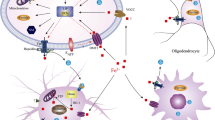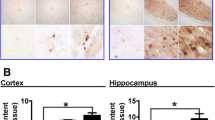Abstract
The mechanisms of iron accumulation in substantia nigra (SN) of Parkinson’s diseases remain unclear. The objective of this study was to investigate effects of nifedipine on iron-overload-induced iron accumulation and neurodegeneration in SN of rats. By high performance liquid chromatography-electrochemical detection, tyrosine hydroxylase (TH) immunohistochemistry, and iron content array, we first quantified iron content and the number of dopamine neurons in SN of experimental rats treated with iron dextran. We further assessed effects of treatment with nifedipine. Our results showed that nifedipine treatment prevents iron dextran-induced dopamine depletion in the striatum. Consistently, we found that nifedipine restores the number of TH-positive neurons reduced by iron dextran overload and prevents increase of iron content in the SN. These results suggested that nifedipine may suppress iron toxicity in dopamine neurons and prevent neurodegeneration.



Similar content being viewed by others
References
Anantharam V, Lehrmann E, Kanthasamy A, Yang Y, Banerjee P, Becker KG, Freed WJ, Kanthasamy AG (2007) Microarray analysis of oxidative stress regulated genes in mesencephalic dopaminergic neuronal cells: relevance to oxidative damage in Parkinson’s disease. Neurochem Int 50:834–847
Andrews NC (1999) Disorders of iron metabolism. N Engl J Med 341:1986–1995
Berg D, Hochstrasser H (2006) Iron metabolism in Parkinsonian syndromes. Mov Disord 21:1299–1310
Blum D, Torch S, Lambeng N, Nissou M, Benabid AL, Sadoul R, Verna JM (2001) Molecular pathways involved in the neurotoxicity of 6-OHDA, dopamine and MPTP: contribution to the apoptotic theory in Parkinson’s disease. Prog Neurobiol 65:135–172
Bradbury MW (1997) Transport of iron in the blood–brain–cerebrospinal fluid system. J Neurochem 69:443–454
Chan CS, Guzman JN, Ilijic E, Mercer JN, Rick C, Tkatch T, Meredith GE, Surmeier DJ (2007) ‘Rejuvenation’ protects neurons in mouse models of Parkinson’s disease. Nature 447:1081–1086
De Waard M, Gurnett CA, Campbell KP (1996) Structural and functional diversity of voltage-activated calcium channels. Ion Channels 4:41–87
Dexter DT, Wells FR, Lees AJ, Agid F, Agid Y, Jenner P, Marsden CD (1989) Increased nigral iron content and alterations in other metal ions occurring in brain in Parkinson’s disease. J Neurochem 52:1830–1836
Faucheux BA, Hirsch EC, Villares J, Selimi F, Mouatt-Prigent A, Javoy-Agid F, Hauw JJ, Agid Y (1993) Distribution of 125I-ferrotransferrin binding sites in the mesencephalon of control subjects and patients with Parkinson’s disease. J Neurochem 60:2338–2341
Faucheux BA, Bonnet AM, Agid Y, Hirsch EC (1999) Blood vessels change in the mesencephalon of patients with Parkinson’s disease. Lancet 353:981–982
Faucheux BA, Martin ME, Beaumont C, Hauw JJ, Agid Y, Hirsch EC (2003) Neuromelanin associated redox-active iron is increased in the substantia nigra of patients with Parkinson’s disease. J Neurochem 86:1142–1148
Gaasch JA, Geldenhuys WJ, Lockman PR, Allen DD, Van der Schyf CJ (2007) Voltage-gated calcium channels provide an alternate route for iron uptake in neuronal cell cultures. Neurochem Res 32:1686–1693
Gotz ME, Double K, Gerlach M, Youdim MB, Riederer P (2004) The relevance of iron in the pathogenesis of Parkinson’s disease. Ann N Y Acad Sci 1012:193–208
He Y, Lee T, Leong SK (1999) Time-course and localization of transferrin receptor expression in the substantia nigra of 6-hydroxydopamine-induced parkinsonian rats. Neuroscience 91:579–585
Jellinger K, Kienzl E, Rumpelmair G, Riederer P, Stachelberger H, Ben-Shachar D, Youdim MB (1992) Iron-melanin complex in substantia nigra of parkinsonian brains: an X-ray microanalysis. J Neurochem 59:1168–1171
Jiang H, Luan Z, Wang J, Xie J (2006) Neuroprotective effects of iron chelator desferal on dopaminergic neurons in the substantia nigra of rats with iron-overload. Neurochem Int 49:605–609
Jiang H, Song N, Wang J, Ren LY, Xie JX (2007) Peripheral iron dextran induced degeneration of dopaminergic neurons in rat substantia nigra. Neurochem Int 51:32–36
Ke Y, Ming Qian Z (2003) Iron misregulation in the brain: a primary cause of neurodegenerative disorders. Lancet Neurol 2:246–253
Koprich JB, Reske-Nielsen C, Mithal P, Isacson O (2008) Neuroinflammation mediated by IL-1beta increases susceptibility of dopamine neurons to degeneration in an animal model of Parkinson’s disease. J Neuroinflamm 5:8
Kupsch A, Sautter J, Schwarz J, Riederer P, Gerlach M, Oertel WH (1996) 1-Methyl-4-phenyl-1,2,3,6-tetrahydropyridine-induced neurotoxicity in non-human primates is antagonized by pretreatment with nimodipine at the nigral, but not at the striatal level. Brain Res 741:185–196
Legssyer R, Geisser P, McArdle H, Crichton RR, Ward RJ (2003) Comparison of injectable iron complexes in their ability to iron load tissues and to induce oxidative stress. Biometals 16:425–433
Ligon B, Boyd AE 3rd, Dunlap K (1998) Class A calcium channel variants in pancreatic islets and their role in insulin secretion. J Biol Chem 273:13905–13911
Linazasoro GJ (2002) Neuroprotection in Parkinson’s disease: love story or mission impossible? Expert Rev Neurother 2:403–416
Lockman JA, Geldenhuys WJ, Bohn KA, Desilva SF, Allen DD, Van der Schyf CJ (2012) Differential effect of nimodipine in attenuating iron-induced toxicity in brain- and blood–brain barrier-associated cell types. Neurochem Res. doi:10.1007/s11064-011-0591-2
Ma ZG, Wang J, Jiang H, Liu TW, Xie JX (2007) Myricetin reduces 6-hydroxydopamine-induced dopamine neuron degeneration in rats. Neuroreport 18:1181–1185
Meissner W, Hill MP, Tison F, Gross CE, Bezard E (2004) Neuroprotective strategies for Parkinson’s disease: conceptual limits of animal models and clinical trials. Trends Pharmacol Sci 25:249–253
Moldzio R, Radad K, Duvigneau JC, Kranner B, Krewenka C, Piskernik C, Rausch WD (2006) Glutamate-induced cell death and formation of radicals can be reduced by lisuride in mesencephalic primary cell culture. J Neural Transm 113:1095–1105
Oudit GY, Sun H, Trivieri MG, Koch SE, Dawood F, Ackerley C, Yazdanpanah M, Wilson GJ, Schwartz A, Liu PP, Backx PH (2003) L-type Ca2+ channels provide a major pathway for iron entry into cardiomyocytes in iron-overload cardiomyopathy. Nat Med 9:1187–1194
Peri R, Triggle DJ, Singh S (2001) Regulation of L-type calcium channels in pituitary GH(4)C(1) cells by depolarization. J Biol Chem 276:31667–31673
Qian ZM, Shen X (2001) Brain iron transport and neurodegeneration. Trends Mol Med 7:103–108
Rouault TA (2001) Iron on the brain. Nat Genet 28:299–300
Schipper HM (1999) Glial HO-1 expression, iron deposition and oxidative stress in neurodegenerative diseases. Neurotox Res 1:57–70
Schurr A (2004) Neuroprotection against ischemic/hypoxic brain damage: blockers of ionotropic glutamate receptor and voltage sensitive calcium channels. Curr Drug Targets 5:603–618
Tsushima RG, Wickenden AD, Bouchard RA, Oudit GY, Liu PP, Backx PH (1999) Modulation of iron uptake in heart by L-type Ca2+ channel modifiers: possible implications in iron overload. Circ Res 84:1302–1309
Wang SQ, Song LS, Lakatta EG, Cheng H (2001) Ca2+ signalling between single L-type Ca2+ channels and ryanodine receptors in heart cells. Nature 410:592–596
Wang J, Jiang H, Xie JX (2004) Time dependent effects of 6-OHDA lesions on iron level and neuronal loss in rat nigrostriatal system. Neurochem Res 29:2239–2243
Xu HM, Jiang H, Wang J, Luo B, Xie JX (2008) Over-expressed human divalent metal transporter 1 is involved in iron accumulation in MES23.5 cells. Neurochem Int 52:1044–1051
Youdim MB, Stephenson G, Ben Shachar D (2004) Ironing iron out in Parkinson’s disease and other neurodegenerative diseases with iron chelators: a lesson from 6-hydroxydopamine and iron chelators, desferal and VK-28. Ann N Y Acad Sci 1012:306–325
Zecca L, Stroppolo A, Gatti A, Tampellini D, Toscani M, Gallorini M, Giaveri G, Arosio P, Santambrogio P, Fariello RG, Karatekin E, Kleinman MH, Turro N, Hornykiewicz O, Zucca FA (2004a) The role of iron and copper molecules in the neuronal vulnerability of locus coeruleus and substantia nigra during aging. Proc Natl Acad Sci USA 101:9843–9848
Zecca L, Youdim MB, Riederer P, Connor JR, Crichton RR (2004b) Iron, brain ageing and neurodegenerative disorders. Nat Rev Neurosci 5:863–873
Zhang L, Lee T, Wang Y, Soong TW (2000) Heterologous expression, functional characterization and localization of two isoforms of the monkey iron transporter Nramp2. Biochem J 349:289–297
Acknowledgments
This study was supported by grants from Natural Science Foundation of China (30800353, 30930036), Outstanding Young Scientist Research Fund of Shandong Province (BS2011YY002) and the Bureau of Science and Technology of Qingdao (09-1-3-80-jch, 10-3-3-1-3-nsh).
Author information
Authors and Affiliations
Corresponding authors
Rights and permissions
About this article
Cite this article
Ma, Z., Zhou, Y. & Xie, J. Nifedipine Prevents Iron Accumulation and Reverses Iron-Overload-Induced Dopamine Neuron Degeneration in the Substantia Nigra of Rats. Neurotox Res 22, 274–279 (2012). https://doi.org/10.1007/s12640-012-9309-8
Received:
Revised:
Accepted:
Published:
Issue Date:
DOI: https://doi.org/10.1007/s12640-012-9309-8




